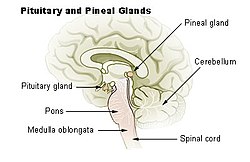There are a lot of glands in the endocrine system so you can do a lot of stuff. We are now going to talk about the thyroid gland, it is one of the biggest endocrine glands, it is found in the neck below the Adam's apple or the thyroid cartilage. The thyroid gland controls how you use your energy, did you know that the thyroid gland is shaped like a butterfly. All the animals that have bones have a thyroid glands like fish, dogs and sharks. It is time to talk about hypothalamus, it is on top of the brain stem and below the thalamus. It is about a size of a almond that is really small but most of the glands are that small because they don't need to be so big. The hypothalamus responses to stress and autonomic inputs and some other stuff. The hypothalamus is responsible for certain metabolic processes.
We are now going to talk about the pineal gland, it is at the middle of the brain between the two hemispheres tucked in a groove where the two rounded thalamic bodies join. and it is very small like all of the glands but it is one of the smallest. It is about the size of a rice grain, it is the shaped like a pine cone but smaller than one. There are a lot of names for this gland these are the other names of the glands they are the pineal body, epiphysis cerebri, epiphysis, conarium or the third eye. It is colored reddish grey, it also affects the modulation of waking and sleeping patterns, the pineal gland is often seen in skull X-rays, you can see a picture showing the pineal gland in the middle of the brain because that is were it is found in like I said before.
We are now going to talk about the parathyroid glands, there are four or more parathyroid glands and they are found the neck, it is very close to the thyroid gland. It is about the size of a rice grain like the gland we we talk about before the pineal gland. The two parathyroid glands at the top are called the superior parathyroid glands and the two parathyroid glands in the bottom is called inferior parathyroid glands. Some people may have six, eight, or even more parathyroid glands. Parathyroid glands control the number of calcium in the blood and within the bones. All animals that are adults and have four limbs have the parathyroid glands. The parathyroid glands were first discovered in the year eighteen fifty that is a long time ago. The parathyroid glands weigh about twenty five milligrams and forty milligrams in humans and that is very light.
We are now going to talk about the adrenal glands, it is two inches long, it is one of the smallest glands in a human body, it is only found in mammals, they are found above the kidneys, there are two adrenal glands they are above both of the kidneys. The weight of the adrenal glands in an adult human is seven to ten grams and that is very light all of the glands are very light because they are small. The adrenal glands are shaped like a triangle. The adrenal glands are the ones who really responses for the release of hormones in response to stress through the synthesis of corticosteroids such as cortisol and catecholamines such as epinephrine and norepinephrine. They also produce androgens. The adrenal glands affect kidney function through the secretion of aldosterone, a hormone involved in regulating the osmolarity of blood plasma. Any way this is the end of my blog.

No comments:
Post a Comment